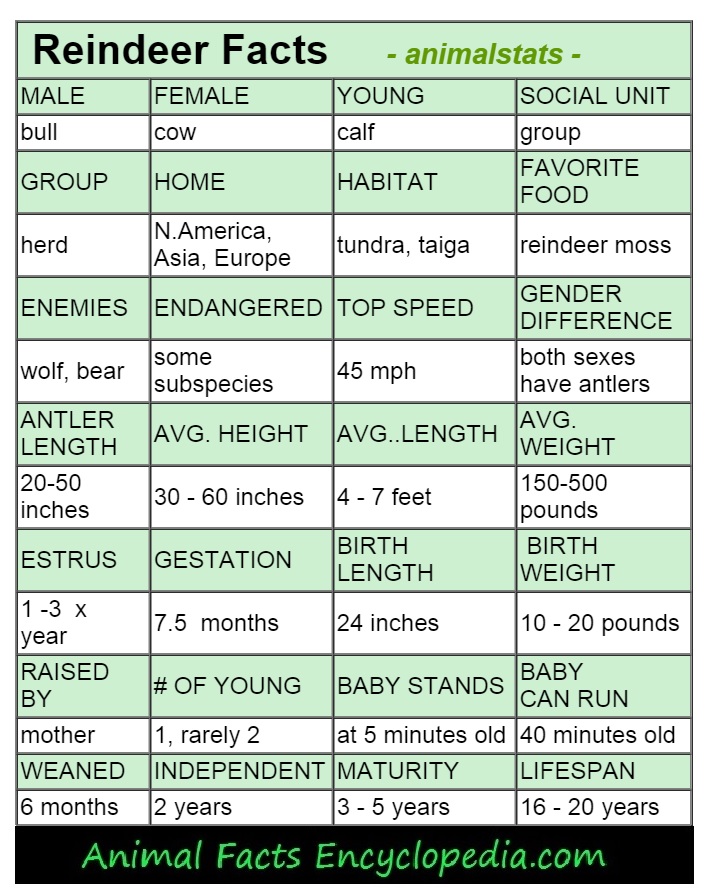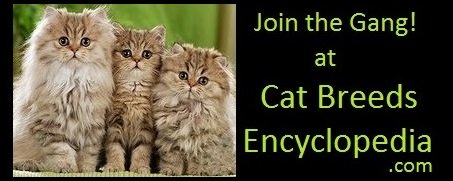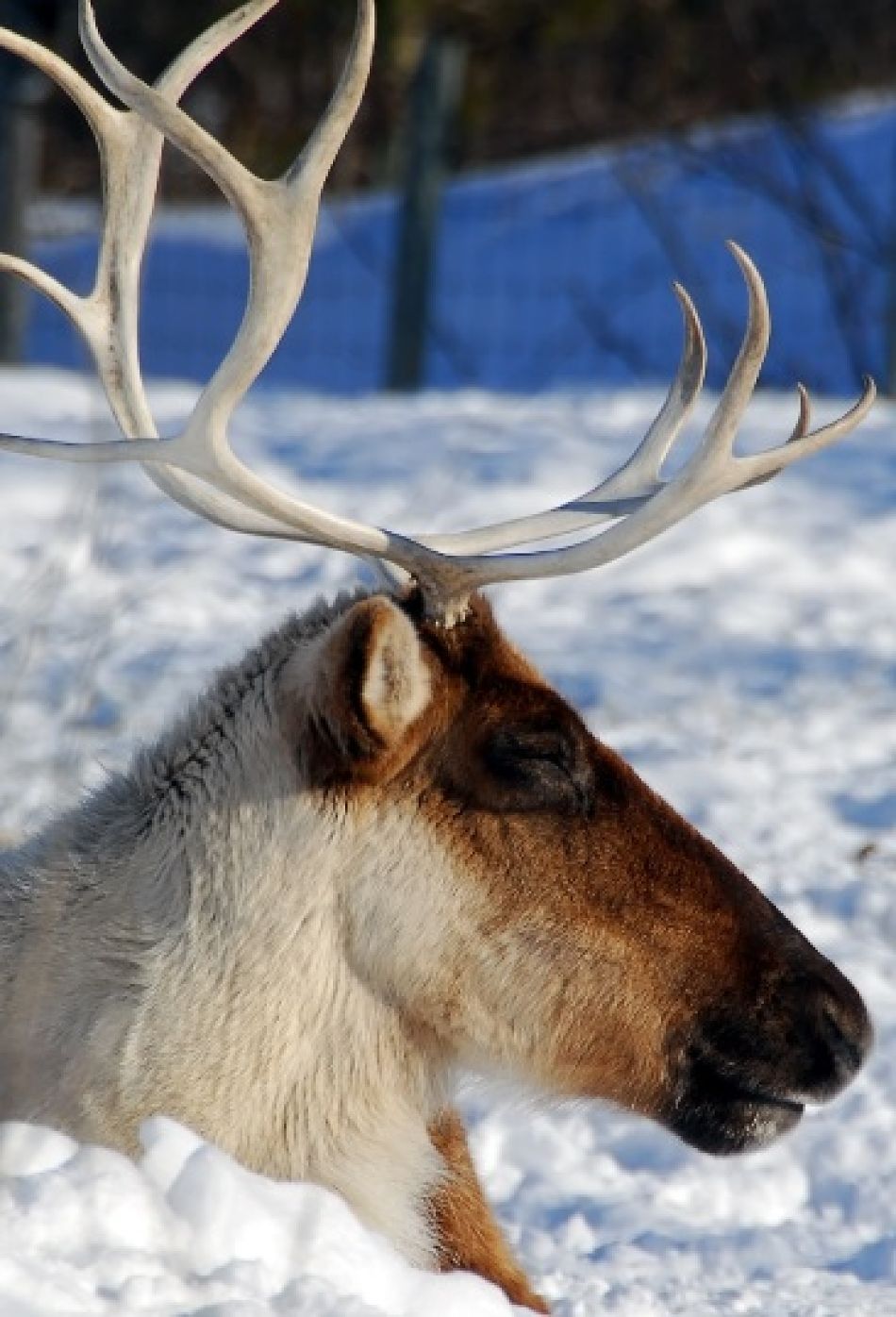reindeer Facts
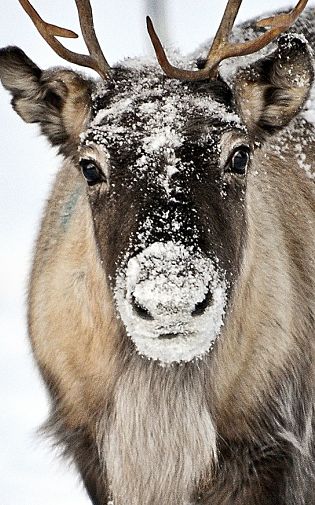 Portrait of a Reindeer
Portrait of a ReindeerThe reindeer is a hardy, ruggedly built deer which lives in the arctic and subarctic regions of the northern hemisphere.
Thriving in the tundra of Europe, Asia and North America, there are numerous subspecies of reindeer with variations in size, color and antler appearance.
Being a species of deer, these animals have antlers, not horns. Antlers differ from horns in that they are not permanent and are regularly shed and regrown.
In Eurasia, it is believed that the reindeer has been domesticated for nearly 7,000 years - longer than the horse!
It is the only species of deer to be domesticated, and also the only species of deer in which both the male and the female grow antlers.
In North America reindeer are known as caribou, and, in general, since the term "reindeer" represents the family or type of deer, one could say all caribou are reindeer, but not all reindeer are caribou.
The North American caribou is approximately 3 subspecies of reindeer which are larger and stockier than the European and Asian reindeer. In addition, although in some reindeer species the female does not have antlers, the females of all North American subspecies do have antlers. Finally, the North American caribou has not been domesticated and is generally a wild animal.
Some of the subtle and various differences between the other subspecies can be attributed to domestication. The various reindeer subspecies in Eurasia vary in appearance from region to region from Greenland, to Siberia to Scandinavia etc.
Local customs and breeding habits naturally cause change as well. There are still wild reindeer in the farthest reaches of Siberia, Norway, Greenland and Finland, but the vast majority of Eurasian reindeer are domestic animals.
Domestication has occurred for so long that these reindeer sometimes have a "pinto" type coloring. The European and Asian native peoples have completely domesticated the reindeer, and their lifestyle is dependent on their relationship with the calm and good-natured domestic reindeer.
In Europe, Scandinavia and Asia, the reindeer is used not just for food and fur, but also for milk, as a pack animal, as a pet, and of course for pulling sleighs!
For the caribou of Alaska and Canada no such domestication has ever occurred. In general, the native people of Alaska and Canada do not herd or maintain caribou, they simply follow wild herds and hunt individual animals as needed for food and fur.
There are dozens of herds of wild caribou in the state of Alaska and their population there is estimated to be more than one million strong.
the nomadic reindeer
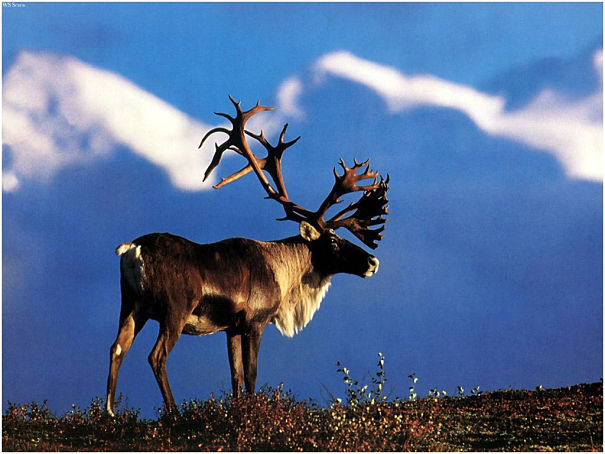

The reindeer of North America, known as "caribou", have the longest migrations of any land animal, with some herds traveling over 3,000 miles and covering nearly 300,000 square miles.
Springtime migration is an enormous event, with multiple small herds coming together in groups of as many as 400,000 animals.
Reindeer are powerful endurance runners. They can sprint at speeds of almost 50 miles per hour, but can travel at 20 miles per hour for extended periods.
When on the move, searching for food, reindeer will cross lakes and rivers en masse and without hesitation, swimming at speeds of 4 to 6 miles per hour, and can leap large gullies and other obstacles with ease.
With amazingly large hearts that carry them further, in harsher environments than any other land animal, the reindeer is a true marathon athlete...
reindeer reproduction
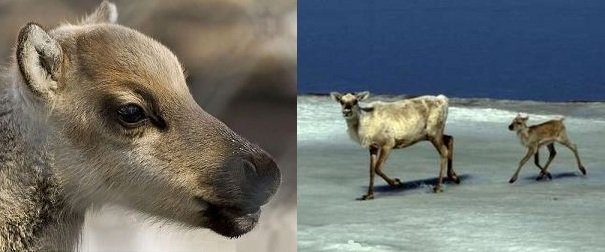
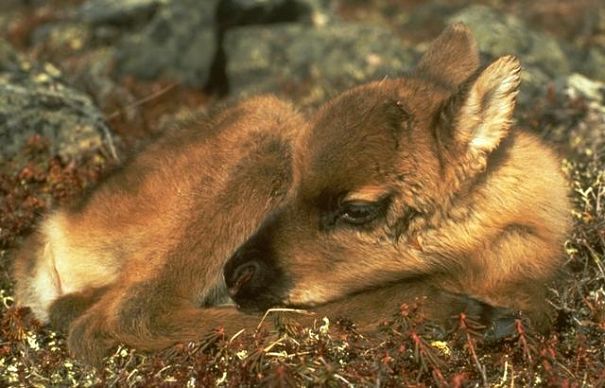
Reindeer live in herds of as few as 10 to as many as 1,000. They have a very typical herd-animal lifestyle with adult males battling each other for territory and the right to mate with females.
Females usually give birth to one calf, on rare occasions two. A newborn baby reindeer is on its feet in minutes and can run as fast as an Olympic sprinter after only half an hour.
By the end of day one, the baby reindeer can keep up with the herd at full speed. Amazingly, the Golden Eagle is the number one predator of baby reindeer, and can actually carry newborn calves away in their talons.
The mother raises the young calf but the whole herd is protective. Reindeer even have an unusual trait that helps them stay together in white-out or blizzard conditions that they experience often in their arctic world - the joints of their knees actually make clicking sounds as they walk so they know they are still with the herd.
Young female reindeer will stay with their mothers and sisters within the same herd their entire lives. Young males usually leave to join a bachelor herd.

"eight tiny reindeer"
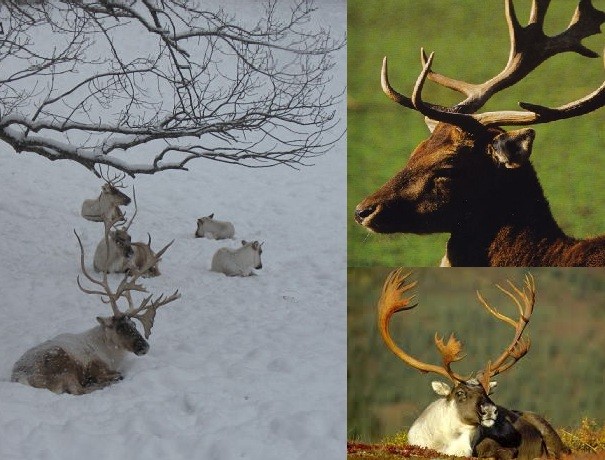 different reindeer subspecies
different reindeer subspeciesSanta's reindeer were described in the famous poem as "eight tiny reindeer". The smallest sub-species of reindeer known is the Svalbard.
Like shetland ponies, these reindeer live on an island off Norway and may have "island dwarfism" as they are about 30 percent smaller than any other reindeer species. - Cool Reindeer Facts
reindeer moss on the rocks
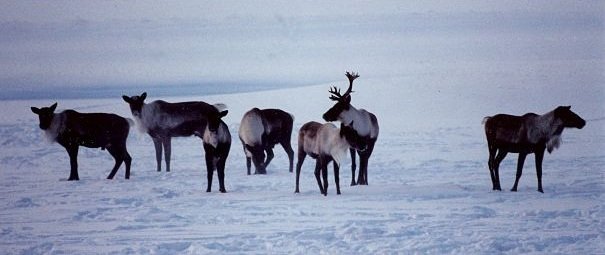
Reindeer are the only mammals in the world specially adapted to eat lichen - a spongey moss that grows on rocks during harsh winter months.
Known as "reindeer moss" it is broken down in the reindeer's stomach by an enzyme completely unique to reindeer. .. Reindeer Facts
a few more reindeer facts
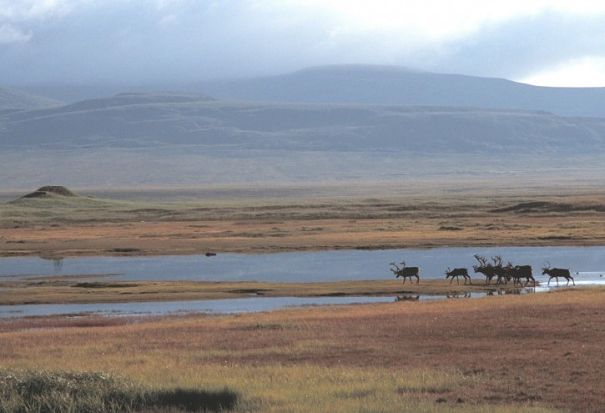
- The reindeer of North America are called "caribou"
- The Eurasian reindeer is the only domestic species of deer
- Reindeer are the only species of deer in which the females usually have antlers
- The reindeer has the largest set of antlers for body mass of all deer - including moose
- A mature male forest reindeer can have an antler spread of over 5 feet
- Some caribou herds have the longest migration of any land animal - over 3000 miles
Scientific Classification:
| Reindeer Facts - animalstats - | |||
|---|---|---|---|
| MALE | FEMALE | YOUNG | SOCIAL UNIT |
| bull | cow | calf | group |
| GROUP | HOME | HABITAT | FAVORITE FOOD |
| herd | N.America, Asia, Europe |
tundra, taiga | reindeer moss |
| ENEMIES | ENDANGERED | TOP SPEED | GENDER DIFFERENCE |
| wolf, bear | some subspecies | 45 mph | both
sexes have antlers |
| ANTLER LENGTH | AVG. HEIGHT | AVG..LENGTH | AVG. WEIGHT |
| 20-50 inches | 30 - 60 inches | 4 - 7 feet | 150-500 pounds |
| ESTRUS | GESTATION | BIRTH LENGTH | BIRTH WEIGHT |
| 1 -3 x year | 7.5 months | 24 inches | 10 - 20 pounds |
| RAISED BY | # OF YOUNG | BABY STANDS | BABY
CAN RUN |
| mother | 1, rarely 2 | at 5 minutes old | 40 minutes old |
| WEANED | INDEPENDENT | MATURITY | LIFESPAN |
| 6 months | 2 years | 3 - 5 years | 16 - 20 years |
see more animal extreme closeups
Recent Articles
-
African Animals - Animal Facts Encyclopedia
Oct 11, 16 10:27 PM
African Animals facts photos and videos..Africa is a wonderland for animal lovers, and a schoolroom for anyone who wants to learn about nature, beauty and the rhythm of life -
Baboon Facts - Animal Facts Encyclopedia
Oct 11, 16 10:26 PM
Baboon facts, photos, videos and information - Baboons are very distinctive looking monkeys with long, dog-like snouts and close set eyes. -
Great Apes Facts - Animal Facts Encyclopedia
Oct 11, 16 10:25 PM
Great apes facts, photos and videos..Human beings did not evolve from chimpanzees, modern chimps and gorillas do not appear in the fossil records until much more recently than homo sapiens..
